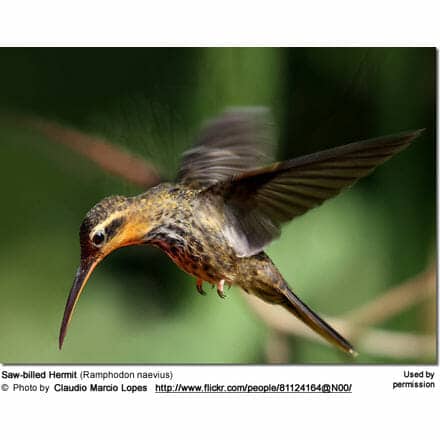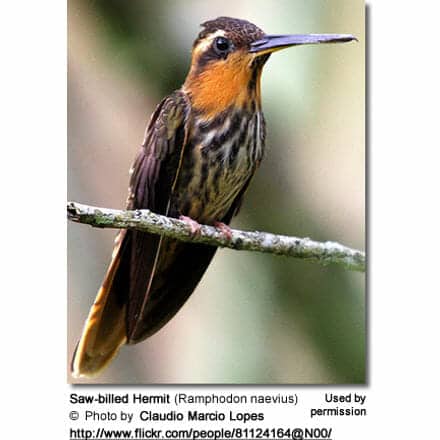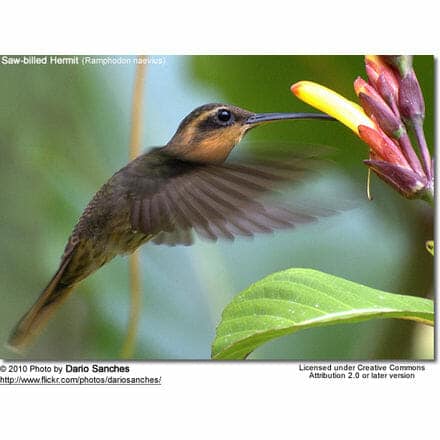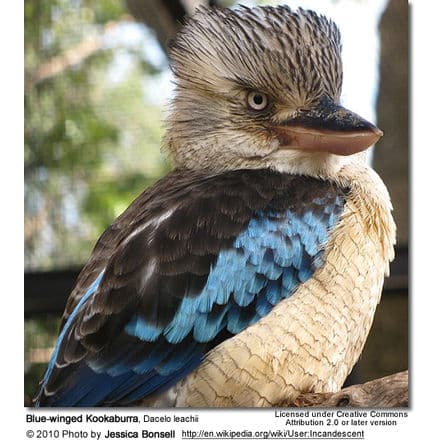Saw-billed Hermits
The Saw-billed Hermits (Ramphodon naevius) is a South American hummingbird that is endemic to southeastern Brazil.
Distribution / Status
The Saw-billed Hermits is relatively common in Atlantic coastal forest areas and second growth, in south-east Brazil (Espírito Santo and Minas Gerais to Rio Grande do Sul), up to elevations of up to 3,000 ft (~900 m). However, there have been sightings in the extreme north of Argentina.
This species is considered endangered due to urbanization, industrialization, agricultural expansion, colonization and road-building – all of which results in loss of suitable habitat. Subsequently, the Saw-billed Hermits are not considered near threatened by Birdlife International.


Description
The Saw-billed Hermits is one of the longest and heaviest hummingbirds, with an average length of 14–16 cm (5.5 – 6.3 inches); and an approximate weight of 10 grams (0.4 oz). The lower bill is pale; the upper bill is dark. It has a straight bill, with a hooked tip. It is named for the tiny serrations on the bill (“saw-billed”).
It ha a heavily streaked chest and distinctive buffy supercilium (“eye-brow”) markings. The throat is orange with a dark stripe down the middle. The roundish tail has buffy-brown tips.
Gender ID: The female’s bill is slightly shorter and she lacks the hooked tip of the male. The male is more strongly marked below.
Similar Species: The Saw-billed Hermit shares many of the physical features of the Hook-billed Hermit, except the Saw-billed Hermit is larger and has bold streaks on the under plumage.
Hummingbird Resources
- Hummingbird Information
- Hummingbird Amazing Facts
- Attracting Hummingbirds to Your Garden
- Hummingbird Species
- Feeding Hummingbirds
Nesting / Breeding
Hummingbirds in general are solitary and neither live nor migrate in flocks; and there is no pair bond for this species – the male’s only involvement in the reproductive process is the actual mating with the female.
During the breeding season, the males of many Hermit species form leks (= competitive mating displays) and congregate on traditional display grounds. Once a female enters their territory, they display for her. Their display may entail wiggling of their tails and singing. Willing females will enter the area for the purpose of choosing a male for mating. Oftentimes she will choose the best singer.
He will separate from the female immediately after copulation. One male may mate with several females. In all likelihood, the female will also mate with several males. The males do not participate in choosing the nest location, building the nest or raising the chicks.
The female Saw-billed Hermit is responsible for building the remarkable cone-shaped nest which hangs by a single strong cable of spiders’ web from some overhead support, which could be a branch or the underside of the broad leaves of, for example, Heliconia plants, banana trees or ferns about 3 – 6 ft (1 – 2 m) above ground.
However, these unusual nests have been found beneath bridges, in highway culverts and even hanging from roofs inside dark buildings. The nest is often near a stream or waterfall. It is constructed out of plant fibers woven together and green moss on the outside for camouflage in a protected location.
She lines the nest with soft plant fibers, animal hair and feather down, and strengthens the structure with spider webbing and other sticky material, giving it an elastic quality to allow it to stretch to double its size as the chicks grow and need more room.
The average clutch consists of two white eggs, which she incubates alone, while the male defends his territory and the flowers he feeds on (although hermit males tend to be less aggressive than the males of other hummingbird species). The young are born blind, immobile and without any down.
The female alone protects and feeds the chicks with regurgitated food (mostly partially-digested insects since nectar is an insufficient source of protein for the growing chicks). The female pushes the food down the chicks’ throats with her long bill directly into their stomachs.
As is the case with other hummingbird species, the chicks are brooded only the first week or two, and left alone even on cooler nights after about 12 days – probably due to the small nest size. The chicks leave the nest when they are about 20 days old.

Diet / Feeding
The Saw-billed Hermits primarily feed on nectar taken from a variety of brightly colored, scented small flowers of trees, herbs, shrubs and epiphytes.They favor flowers with the highest sugar content (often red-colored and tubular-shaped).




